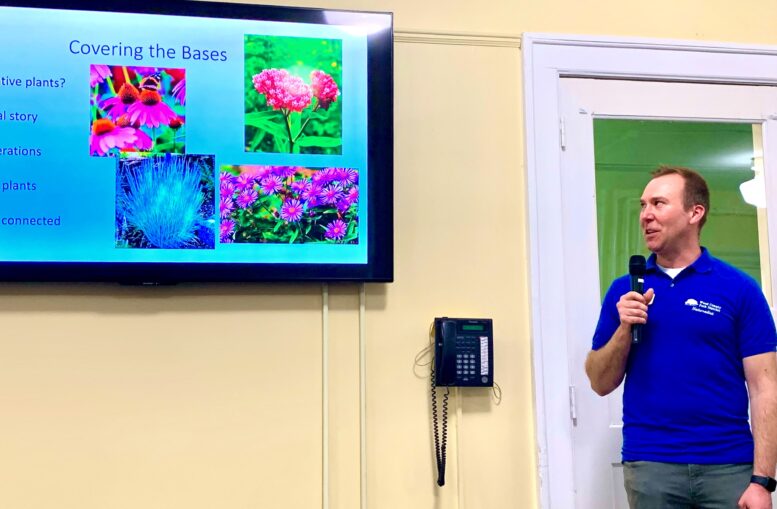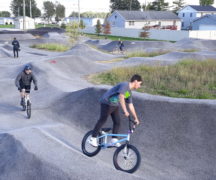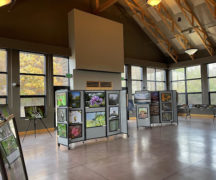By JULIE CARLE
BG Independent News
Plants native to Ohio can be a boon to local gardens and wildlife.
“Native plants are part of a valuable ecosystem that benefits insects, pollinators, birds, wildlife and people,” Jim Witter, program manager for the Wood County Park District, said during a recent program at the Wood County Museum.
Why native plants? They are adapted to local conditions over hundreds or thousands of years and are vital to providing quality food for wildlife, such as caterpillars, and shelter for birds and other animals. They offer habitat for migrating birds and butterflies and attract butterflies and other pollinators in search of nectar and pollen.
Native plants come in the form of grasses, sedges, flowers, shrubs and trees, and are important connectors in the ecosystem, Witter said. For example, oak trees have many different connections from food or as a host to insect species and other wildlife.
Anyone can add value by planting native plants, regardless of where they live, he said. Pocket prairies, which introduce native plants to an area, can be planted in large areas or as small as container gardens for apartment dwellers.
“Even with a little small garden next to your lawn, there are insects, butterflies, birds or animals that might show up and use that,” Witter said. “And lawns are not completely devoid of value. There are some animals that can use a lawn, but not as many as can use a prairie or woods landscape.”
National parks in the U.S. account for approximately 48 million acres. “If we planted half of the country’s acreage that is in private lands and lawns, it would be larger than several of those national parks,” he said.
As more people add native plants to their landscapes, food sources and habitats can be built up. “If everyone does it together, even a small bit, everything can add up to a lot,” Witter said.
There are even spaces in urban settings that can benefit from having native plants, such as street edges, vacant lots, gap spaces and even under powerlines. He mentioned the Toledo Zoo has a program to plant native plants on vacant lots to create pocket prairies.
Local park districts including Wood County, Toledo Metroparks and the Black Swamp Conservancy “protect wild areas around northwest Ohio. “They are all great places and serve the community because people enjoy being in nature, around animals and being able to relax,” he said.
“We have large tracts of woodlands or prairies that are serving animals and helping with water quality. We are part of this ecosystem.”
Witter became interested in native plants after joining the Wood County Park District as “the bird guy.” He learned about the greenhouse at the JC Reuthinger Memorial Preserve and loved talking about it. However, he realized if he was going to help educate park patrons, he should probably educate himself and put native plants in his yard.
A mentor happened to have an abundance of native plants she was giving away. “That’s how I got started,” he said.
Witter knew he had to think about the sun, shade and soil type, but he decided to forge ahead thinking of the process as an adventure. “I was starting something new, but I just wanted to put plants into the ground and see if they grew or not. That was the way I went about it,” he said with a laugh.
Witter involved his children in his “weird dad hobby” with the hope of “planting the seeds of gardening.”
He did make mistakes, including not getting rid of the grass completely and putting a spicebush in a wrong location.
Witter also admitted that other people interested in pursuing a native plant garden “might want to be more meticulous.”
Some things to think about before digging into a native plant garden include soil type, sun availability, what conditions a plant likes, colors, plant groupings, yard size and bloom timing.
There are online soil tests available, but Ohio State University Extension and Soil and Water Conservation Districts often can provide soil testing.
“Some plants like to be wet, like the Cardinal flower, it’s impossible to overwater them,” he said. Others, like the lupine thrive best in sandy, well-drained soils.
Knowing what you want to attract is another aspect to consider.
Blue lupine, which grow in sandy soils in the region, is the only host for the caterpillar of the endangered Karner blue butterfly. The plant attracts other butterflies and pollinators as well.
Common milkweed is known to attract monarchs, but it is also a plant that can be very aggressive. “Native plants are great, but they do have some different growing methods,” he said.
Oaks, hickories and cherry trees are families of trees that are the number one source of healthy food and nutrition for caterpillars. Migrating birds—warblers and nesting birds— also find the native trees a good source of food and habitat.
“Non-native trees still have value, but they don’t have the food that species have adapted to eat,” Witter said.
He suggested being creative with garden designs either through experimentation or seeking information from experts. There are plenty of resources available for designing a garden with native plants. Park systems, the Toledo Zoo, nurseries and garden centers often can help guide gardeners interested in incorporating native plants into their landscapes.
The Wood County Park District Native Plant sale is a good source for healthy and appropriate plants for this area, he said. This year’s sale for the public is May 4 from 10 a.m. to 2 p.m. at the Champion Barn on the Wood County Fairgrounds. Members of the Friends of the Wood County Parks have first access to the sale on May 3.
There are other local nurseries and greenhouses that sell native plants, including North Branch Nursery in Pemberville, Blue Creek Greenhouse in Whitehouse, which is part of the Toledo Metroparks and Liv’s Native Nursery in Michigan.
For people who aren’t quite ready to landscape their own yards with native plants, there are other local opportunities to practice the skills, increase their knowledge about native plants, and connect with a gardening community, Witter said. “You can come practice with us.”
Related to native plants, the Wood County Park District accepts volunteers for Adopt-a-Garden and Adopt-a-Seed-Collecting-Bed at various parks in the district. Volunteers also meet on Tuesdays from 10 a.m. to noon to help in the greenhouse at JC Reuthinger Memorial Preserve, 30730 Oregon Road, Perrysburg.
Adopt-a-Garden brings people together to make a difference in local conservation efforts by adopting a native plant garden or seed-collecting bed. An information session is planned from 6 to 7 p.m. Tuesday, April 2 at the Reuthinger Preserve.
The Black Swamp Herb Society, which maintains four demonstration plots of herbs behind the Wood County Museum, is also looking for volunteers, said Lynn Deters. “The work is not too taxing,” said Lynn Deters, a member of the herb society. “After the spring planting, the work is simple—mainly weeding and dead-heading.” For more information, contact Deters at ddeters@dacor.net.
“You may not be an expert, but start somewhere, either as a volunteer or in your own garden,” Witter said. “You learn by doing. Make a garden your own.”





